Architecture is the device to explore wider themes in Brady Corbet’s ambitious three-and-a-half-hour-plus epic that looks set to sweep The Oscars, writes Sarah Simpkin
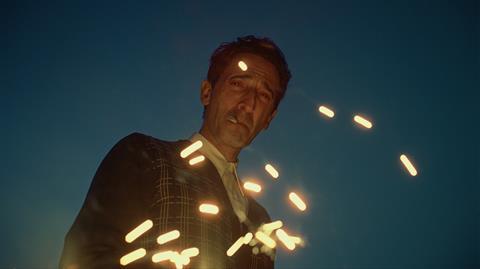
Please note: This review includes plot details
I didn’t go to see The Brutalist at the Barbican, but at the Curzon Mayfair. Its coffered ceilings and bas-relief walls aren’t brutalist, no. But given the cinema’s battles against development, it felt right for a film based around preserving the integrity of an architectural vision against commercial forces. And it’s a nice cinema, isn’t it?
This willingness to indulge technical inaccuracies is significant because The Brutalist isn’t really about brutalism either. Architecture is the device to explore wider themes of trauma, the Holocaust, migration, addiction, marriage, art and power.
The film tells the story of Hungarian-Jewish architect and Holocaust survivor László Tóth, played by Adrian Brody. He sails to the United States to rebuild his life after the war. In the first part, we follow his struggles as he moves from New York to Pennsylvania, where his cousin has a furniture shop. His fortunes change when he meets wealthy industrialist Harrison Lee Van Buren, played with unsettling mercurial menace by Guy Pearce.
Without ruining the plot too much, Tóth gets his big commission: a monumental building on the summit of a hill, as a tribute to Van Buren’s mother. The brief is for a gymnasium, chapel, theatre and library in a single building. His design concept for this multifunctional memorial seems to rest entirely on some high concrete walls and a simple, Ando-ish crucifix of light.
The architects I have spoken to about the film have gone straight for its inaccuracies. I was told an Ayn Rand-style hero with a glory project misrepresents Brutalism’s social ideals. Another critiqued the water in the building – “why?”
It bears saying that this is fiction, not a documentary. In the same way that the houses of Lannister and Stark aren’t an accurate retelling of the Wars of the Roses.
The film is in four sections – overture, two parts divided by an interval, then epilogue – and this first act could be seen as a straightforward story of wish fulfilment for some: your talent is discovered by a wealthy patron, who rewards your (lone, male) genius with carte blanche on a big cultural project.
There are built instances of it happening, but I can see how architects trapped in today’s procurement riddle of having to prove you have built something before you get an opportunity to try, might bristle.
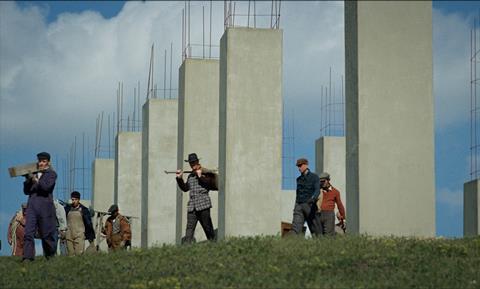
Art mirrors life in both Tóth’s project and the scale and ambition of the film itself. After modest success with his two previous films, director Brady Corbet and co-writer Mona Fastvold seem to have come out of relative nowhere with this whopping three hours and 35 minutes epic, to a predicted Oscars sweep.
Tóth has a singular vision for his building, and for his place in architectural history, both of which he is unwilling to corrupt. Despite his struggles for survival, he doesn’t work for another architect until later, when he is reunited with his wife, Erzsébet, and niece, Zsófia.
It appears that until it is necessary then, he would rather shovel coal. As Zsófia says in the finale, with typical biennale understatement: “My uncle is, above all, a principled artist. His lifelong ambition was not only to define an epoch but to transcend all time.”
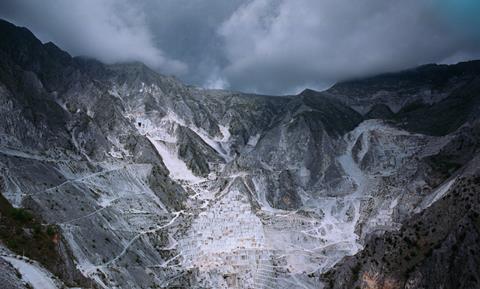
And what of the ensemble cast, the buildings? His first commission, the renovation of Van Buren’s library (although completed, implausibly, in a matter of days) is light and spectacular. Production designer Judy Becker has been nominated for an Oscar for her work, which blends models, set design and inventive location scouting – the interior scene that looks like a submerged Johnson Wax building was filmed in Budapest’s reservoir, hence why it is wet.
The film has an 18 certificate – again, a hint this isn’t a documentary about Brutalism. For architects, the most risqué scene is probably when Orazio, the long-haired Italian anarchist guiding them through the Carrara stone quarry, pours a bottle of water down a slab of marble. Its veins emerge, Van Buren presses his cheek to the surface. The later party scene at the quarry was filmed in catacombs beneath Budapest – it’s ironic that much of the film was shot in Hungary.
I didn’t walk away from the cinema thinking about architecture, concrete or otherwise, but about the mirage of the American Dream
On the authenticity point, it feels like there is at least a bit of knowing ambiguity in some of the details, in particular the names. The contractor is Leslie Woodrow. It’s Miller & Sons furniture, just shy of Herman Miller. László could be a reference to the artist László Moholy-Nagy, although he is biographically closer to Marcel Breuer, with his Bauhaus education, metal chair and the typography of the credits, angled like the cover of Internationale Architektur. You know what, though, it doesn’t entirely matter.
The depiction of the architects’ lot is credible enough for its narrative purpose. I appreciated the line at a dinner, when Van Buren seeks to endorse Tóth’s reputation: “There have been many features about him in the architectural journals, if you follow that sort of thing.”
There’s a public consultation too. Tóth’s presentation, his clear, assured responses, reminded me of Norman Foster pitching 425 Park Avenue.
The architects’ role on site is typically all-consuming, until it isn’t. Then a familiar refrain when faced with a project on hold: “I’ll work something out.”
There is an explosive confrontation on value engineering between the architect, the client’s architectural advisor and the contractor. It’s remarkable to see a Hollywood film dedicate such drama to ceiling heights and fee negotiations. Engineers don’t get much, if any, screentime though, as is often the way.
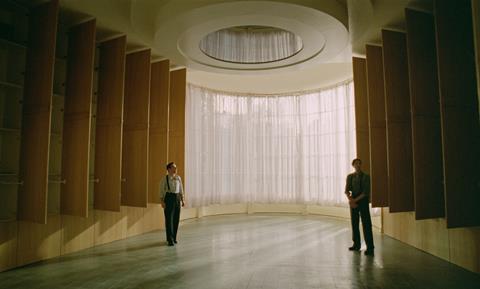
The final act, the epilogue, jumps ahead to 1980 and the first Venice architecture biennale. This part feels a bit disconnected, perhaps deliberately. Behind the stage, we see a set of very flimsy PoMo screens, suggesting a hollow chasm between architecture’s telling and the reality of a building’s making.
If you decide to see it, try to catch it on a big screen in a great venue. Not to appreciate the monumental scale close-up, as it’s actually quite hard to make sense of Tóth’s eventual building. It is only glimpsed in fragments; there’s no fly-through for the benefit of those that want to understand it in plan.
Watch it for the nuances of expression, for the outstanding performances from Brody, Felicity Jones and Pearce – and for the effect of the excellent soundtrack, composed by London artist Daniel Blumberg.
I didn’t walk away from the cinema thinking about architecture, concrete or otherwise, but about the mirage of the American Dream, as the film presents it. What it represented after the war for European émigrés, compared to the brutality of Tóth’s fictional experience of homelessness, addiction and antisemitism – and what it means now, as Donald Trump begins his term in office, signing executive orders about how buildings should look.
Sarah Simpkin is a writer and



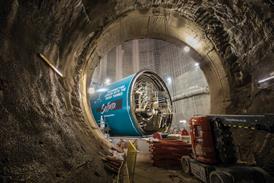








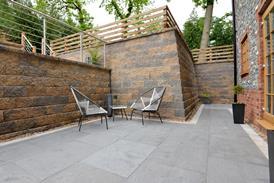


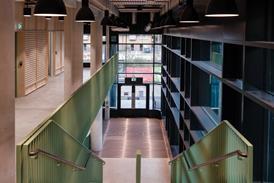







No comments yet